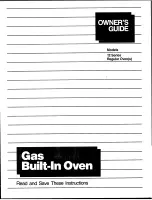
en
Tested for you in our cooking studio
36
Covered cookware
When cooking with covered cookware, the cooking
compartment remains considerably cleaner. Ensure that
the lid fits well and closes properly. Place the cookware
onto the wire rack.
Very hot steam may escape when opening the lid after
cooking. Lift the lid at the rear, so that the hot steam
can escape away from you.
Poultry can also become crispy in a covered roasting
dish. To do so, use a roasting dish with a glass lid and
set a higher temperature.
Grilling
Keep the appliance door closed when using the grill.
Never grill with the appliance door open.
Place the food to be grilled on the wire rack. In addition,
slide the universal pan in at least one shelf position
lower, with the slanted edge facing the appliance door.
Any dripping fat will be caught.
When grilling, try wherever possible to use pieces of
food which are of a similar thickness and weight. This
will allow them to brown evenly and remain succulent
and juicy. Place the food to be grilled directly onto the
wire rack.
Use tongs to turn the pieces of food you are grilling. If
you pierce the meat with a fork, the juices will run out
and it will become dry.
Notes
■
The grill element switches itself continuously on and
off; this is normal. The set temperature determines
how frequently this occurs.
■
Smoke may be produced when grilling.
Recommended setting values
In the table, you can find the ideal heating type for the
kind of poultry you are cooking. The temperature and
cooking time depend on the amount, composition and
temperature of the food. Setting ranges are indicated
for this reason. Try using the lower values at first. You
can increase the temperature next time if necessary.
The setting values are based on the assumption that
unstuffed, chilled, ready-to-roast poultry is placed into a
cold cooking compartment. By doing so, you can make
energy savings of up to 20 per cent. If you preheat the
oven, the indicated cooking times will be reduced by
several minutes.
In the table, you can find specifications for poultry with
default values for the weight. If you wish to cook heavier
poultry, use the lower temperature in every case. If
cooking multiple pieces, use the weight of the heaviest
piece as a reference for determining the cooking time.
The individual pieces should be approximately equal in
size.
A general rule: the larger the poultry is, the lower the
cooking temperature and the longer the cooking time.
Turn the poultry after approx.
^
to
Z
of the indicated
time.
Note:
Only use greaseproof paper that is suitable for
the selected temperature. Always cut greaseproof
paper to size.
Tips
■
For duck or goose, pierce the skin on the underside
of the wings. This allows the fat to run out.
■
If using duck breast, score the skin. Do not turn duck
breasts.
■
When you turn poultry, ensure that the breast side or
the skin side is underneath at first.
■
Poultry will turn out particularly crispy and brown if
you baste it towards the end of the roasting time with
butter, salted water or orange juice.
Remove unused accessories from the cooking
compartment. This will achieve the best possible
cooking results and energy savings of up to 20 per
cent.
Types of heating used:
■
ƒ
Top/bottom heating
■
‡
Circo-roasting
■
„
Pizza setting
■
ˆ
Grill, large area
Dish
Accessories/cookware
Shelf posi-
tion
Type of
heating
Tempera-
ture in °C
Cooking
time in
mins.
Chicken
Chicken, 1 kg
Wire rack
2
‡
200-220
60-70
Chicken breast fillet, 150 g each (grilling)
Wire rack
4
ˆ
275*
15-20
Small chicken portions, 250 g each
Wire rack
3
‡
220-230
30-35
Chicken goujons, nuggets, frozen
Universal pan
3
„
190-210
20-25
Poulard, 1.5 kg
Wire rack
2
‡
200-220
70-90
Duck and goose
Duck, 2 kg
Wire rack
1
‡
180-200
90-110
Duck breast, 300 g each
Wire rack
3
‡
230-250
17-20
Goose, 3 kg
Wire rack
2
‡
160-180
120-150
Goose legs, 350 g each
Wire rack
2
‡
210-230
40-50
* Preheat for 5 mins
Содержание B48CT64N0
Страница 1: ... en INSTRUCTION MANUAL Built in oven B48CT64 0 ...
Страница 2: ......
Страница 50: ...6 ...
Страница 51: ...6 ...
















































